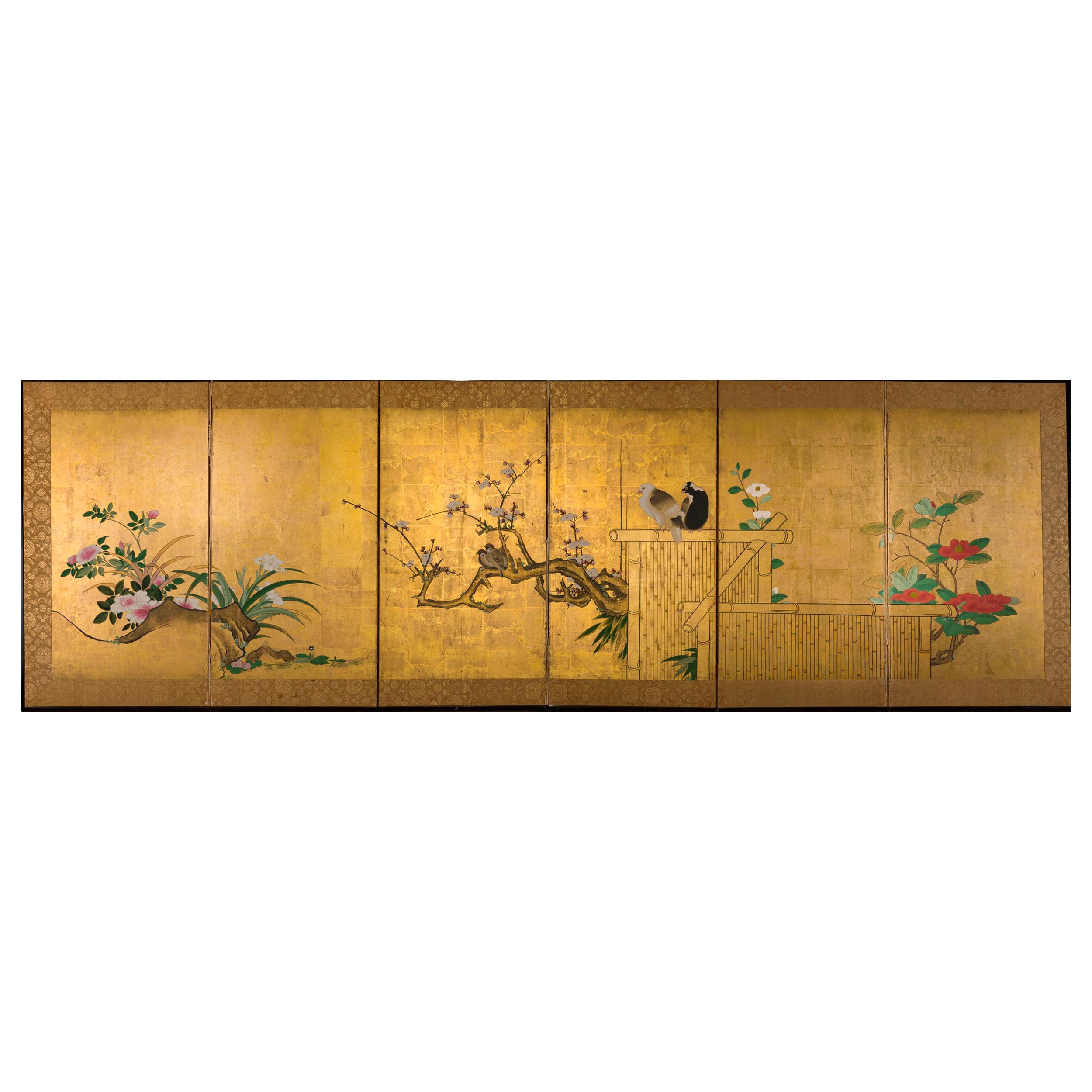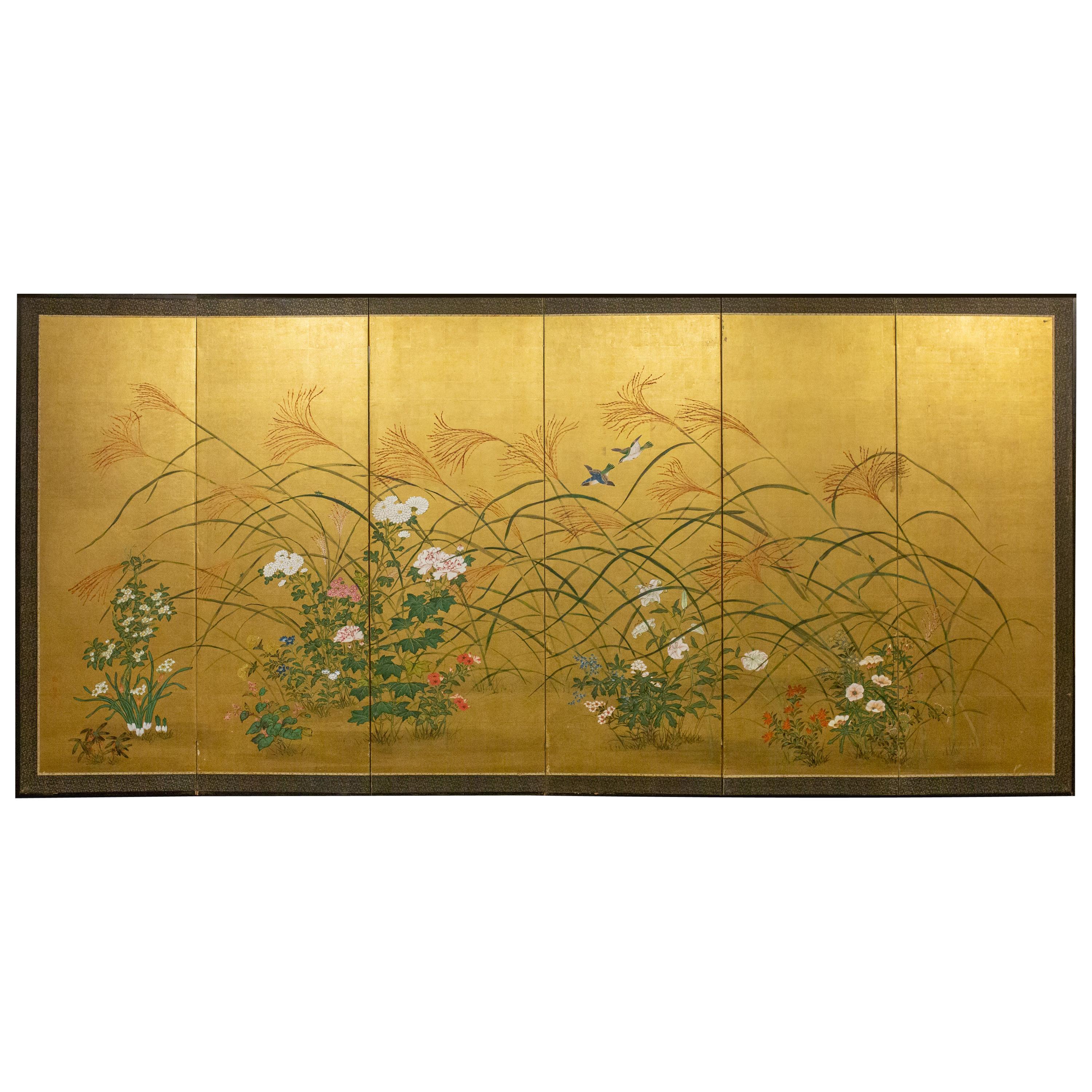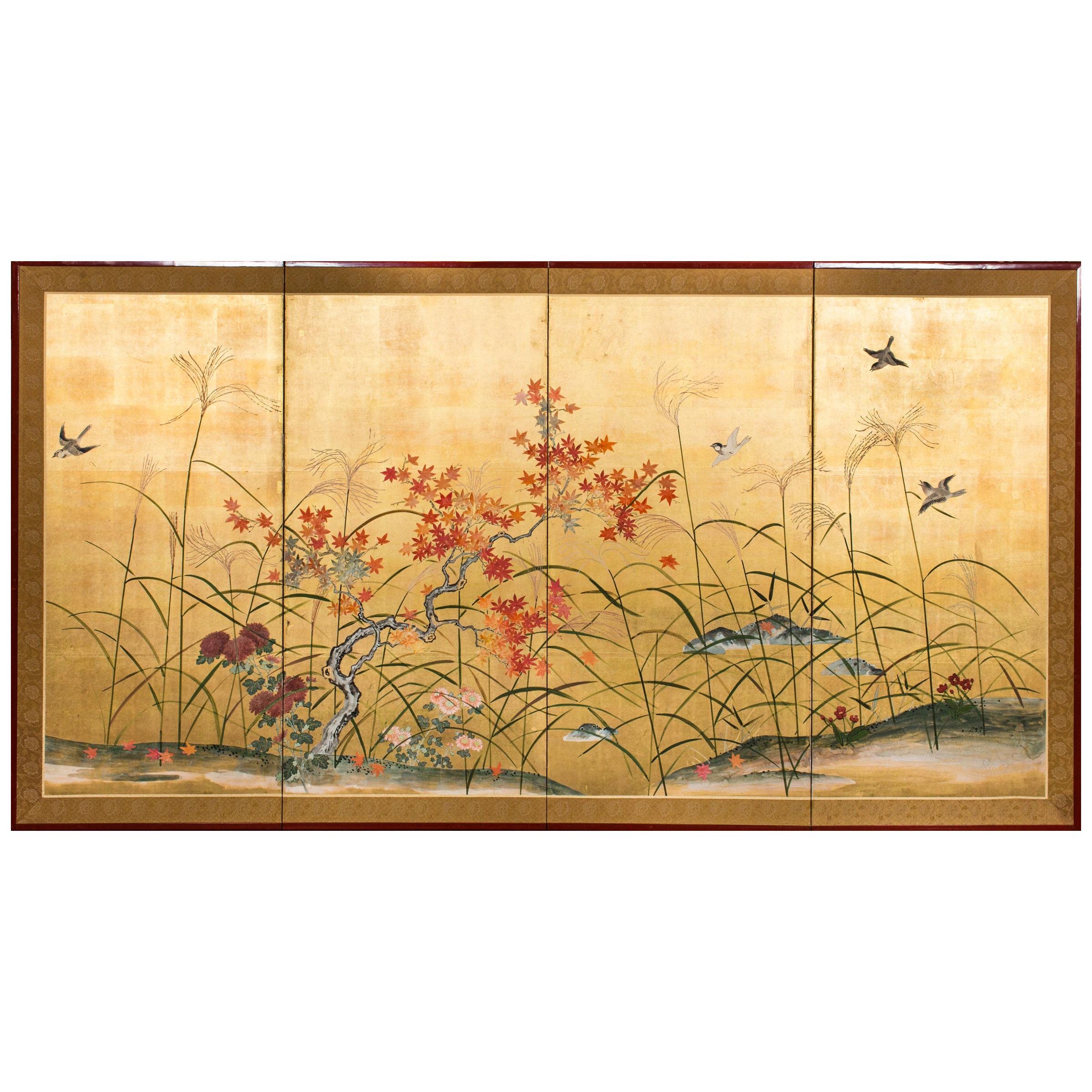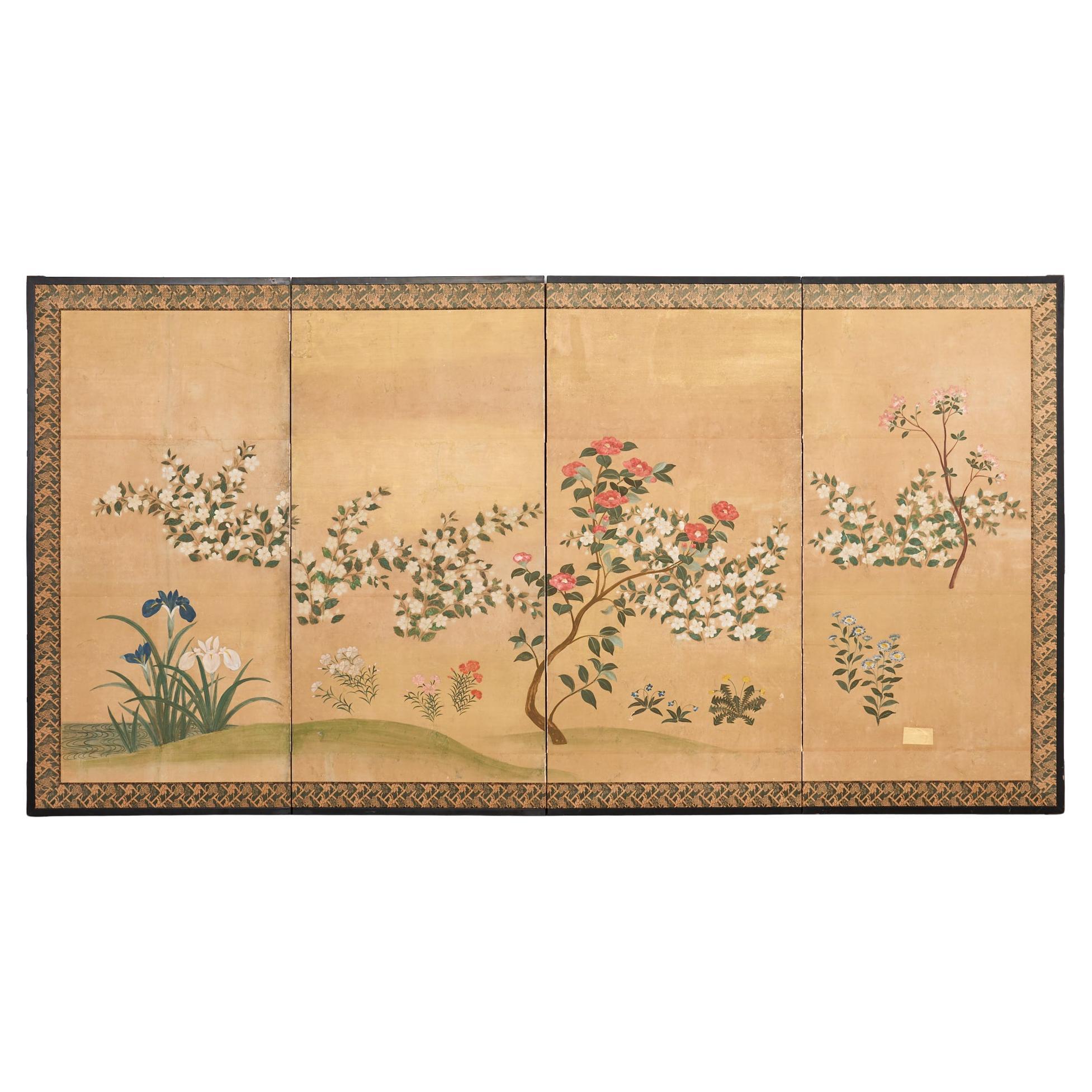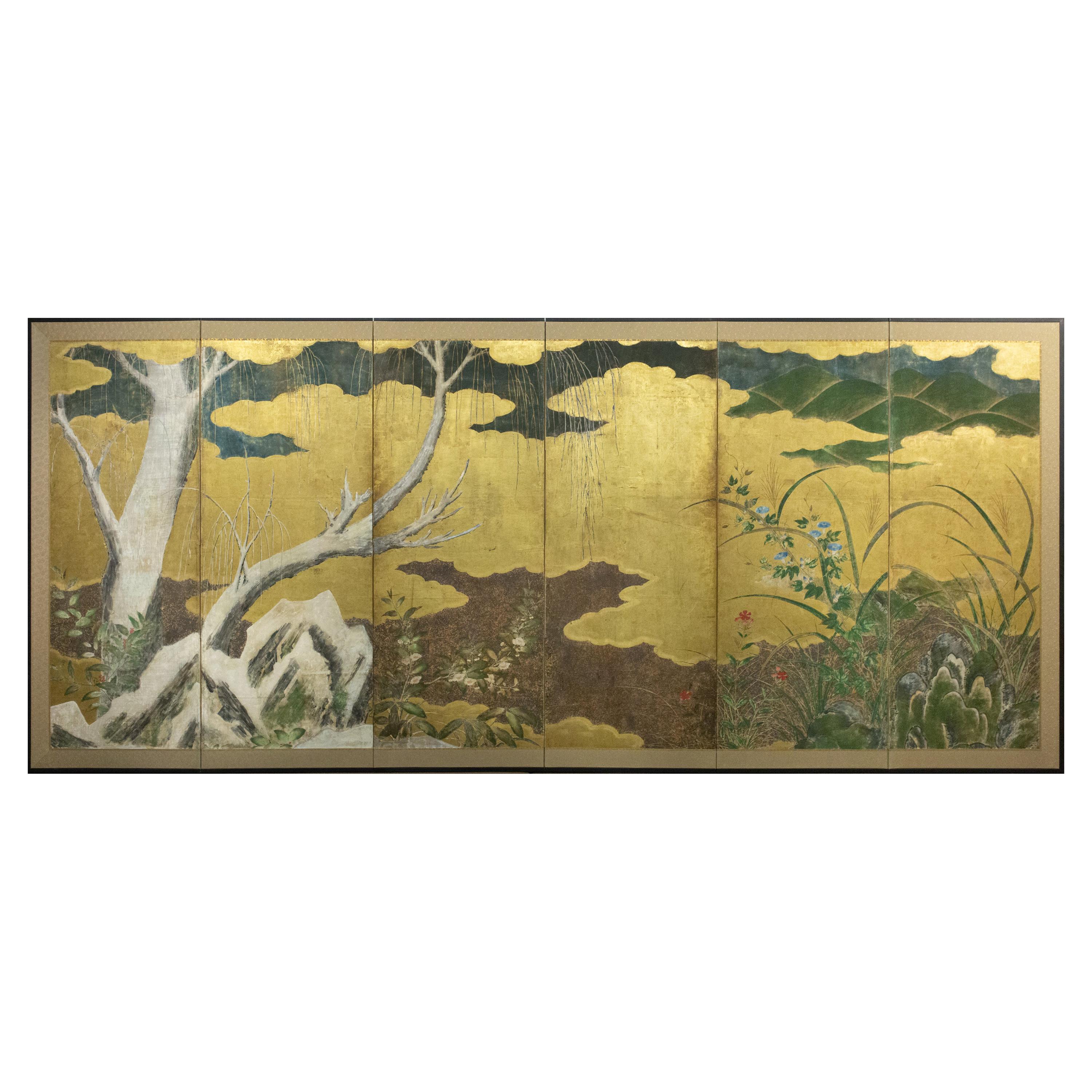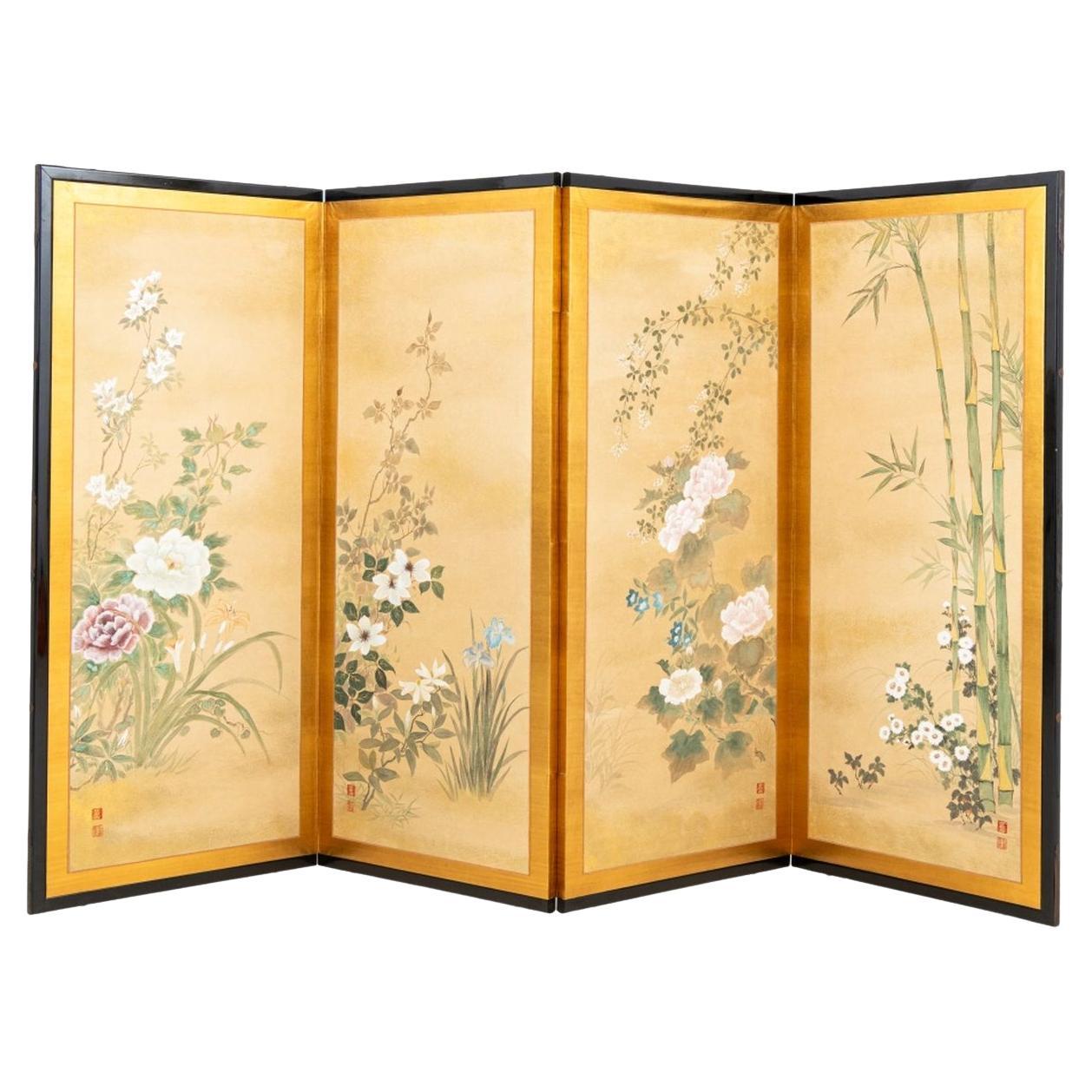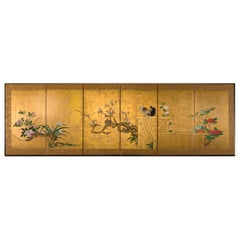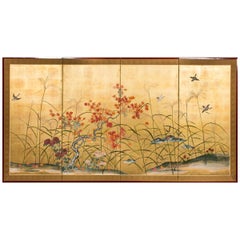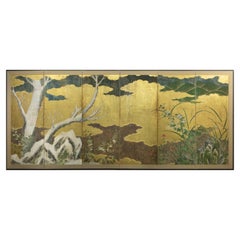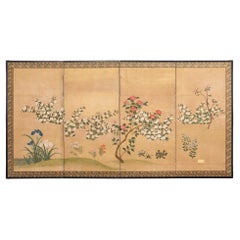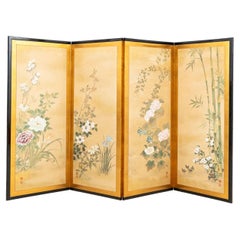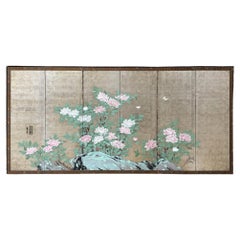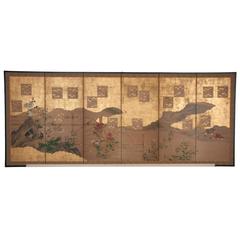Items Similar to Japanese Four Panel Screen: Early Spring Into Summer
Want more images or videos?
Request additional images or videos from the seller
1 of 8
Japanese Four Panel Screen: Early Spring Into Summer
$12,000
£9,067.69
€10,495.08
CA$16,835.41
A$18,725.80
CHF 9,823.53
MX$228,497.36
NOK 123,297.72
SEK 116,193.14
DKK 78,341.31
About the Item
Japanese Four Panel Screen: Early Spring Into Summer, Meiji period (1868 -1912) painting of plum in bloom with red camellias on the right and peony and thistle on the left. A clutch of sparrows explore the ground beneath the blossoming flowers. Mineral pigments painted on mulberry paper with gold dust and a silk brocade border. Signature reads: Inen.
- Dimensions:Height: 34.75 in (88.27 cm)Width: 98 in (248.92 cm)Depth: 0.75 in (1.91 cm)
- Style:Meiji (Of the Period)
- Materials and Techniques:
- Place of Origin:
- Period:1900-1909
- Date of Manufacture:c. 1900
- Condition:Details on request.
- Seller Location:Hudson, NY
- Reference Number:Seller: S14021stDibs: 1306138551817
About the Seller
5.0
Recognized Seller
These prestigious sellers are industry leaders and represent the highest echelon for item quality and design.
Established in 1971
1stDibs seller since 2008
166 sales on 1stDibs
Typical response time: 6 hours
Associations
The Art and Antique Dealers League of AmericaAntiques Associations Members
- ShippingRetrieving quote...Shipping from: Hudson, NY
- Return Policy
Authenticity Guarantee
In the unlikely event there’s an issue with an item’s authenticity, contact us within 1 year for a full refund. DetailsMoney-Back Guarantee
If your item is not as described, is damaged in transit, or does not arrive, contact us within 7 days for a full refund. Details24-Hour Cancellation
You have a 24-hour grace period in which to reconsider your purchase, with no questions asked.Vetted Professional Sellers
Our world-class sellers must adhere to strict standards for service and quality, maintaining the integrity of our listings.Price-Match Guarantee
If you find that a seller listed the same item for a lower price elsewhere, we’ll match it.Trusted Global Delivery
Our best-in-class carrier network provides specialized shipping options worldwide, including custom delivery.More From This Seller
View AllJapanese Six-Panel Screen Late Winter into Early Spring
Located in Hudson, NY
Japanese six-panel screen: Late winter into early spring, Rimpa style painting of a garden scene with doves on a bamboo fence. Flowers in bloom including ...
Category
Antique Early 19th Century Japanese Edo Paintings and Screens
Materials
Gold Leaf
Japanese Six-Panel Screen, a Garden for All Seasons
Located in Hudson, NY
An imaginary garden with flowers from all seasons including spring lilies, summer hibiscuses, autumn chrysanthemums, and winter berries. Wild autumn grasses move in a soft breeze wit...
Category
Antique 1890s Japanese Meiji Paintings and Screens
Materials
Gold Leaf
Japanese Four Panel Screen, Autumn Flowers
Located in Hudson, NY
Taisho period painting (1912-1926) of a fall landscape with wild grasses, red maple, and dahlias. Mineral pigments on gold with a silk brocade border and beautiful metal mounts.
Category
Vintage 1920s Japanese Taisho Paintings and Screens
Materials
Silk, Wood, Paper
Japanese Six-Panel Screen Winter Into Spring
Located in Hudson, NY
With snow-covered willow tree, garden stone and winter berries. Right panels have spring flowers and a view of hills in the distance (likely the Higashiyama Hills painted in Kyoto by...
Category
Antique 18th Century Japanese Edo Paintings and Screens
Materials
Gold Leaf
Japanese Two Panel Screen: Winter into Spring Floral Landscape
Located in Hudson, NY
With nandin, narcissus and chrysanthemums. Signature and seal read: Koun. Mineral pigments on mulberry paper with a silk brocade border.
Category
Early 20th Century Japanese Paintings and Screens
Materials
Brocade, Silk, Paper
Japanese Six Panel Screen by Garden’s Edge
Located in Hudson, NY
Edo period (18th century) painting of a flowing array of various types of chrysanthemums painted on beautifully faceted heavy gold leaf and behind afinely painted fence. Petals of th...
Category
Antique 18th Century Japanese Paintings and Screens
Materials
Gold
You May Also Like
Japanese Showa Four Panel Screen Spring Flowers on Gilt
Located in Rio Vista, CA
Charming mid-20th century Japanese Showa period four-panel folding byobu screen featuring blossoming spring flowers over a bold gilt background. The painting depicts iris, camella, w...
Category
20th Century Japanese Showa Paintings and Screens
Materials
Brass
Japanese 4-Panel Byobu Screen
Located in Astoria, NY
Japanese Four Panel Byobu Screen, with hand-painted scenes of flowers within gilt borders, chop seal marks to each panel. Larger panels: 38.75" H x 17.25" W x 1" D. Provenance: From ...
Category
Late 20th Century Japanese Ming Paintings and Screens
Materials
Hardwood, Paper
1939 years Japanese six-panel "Spring Reverie" Screen
Located in Fukuoka, JP
Spring Reverie
Period: Showa
Year: 1939
Size: 358 x 173 cm (140.9 x 68.1 inches)
SKU: SD230
This exquisite 6-panel screen captures the ethereal beauty of spring through the depict...
Category
20th Century Japanese Showa Paintings and Screens
Materials
Wood, Paper
Japanese Six-Panel Screen
Located in Stamford, CT
A six-panel Japanese paper screen with poems, autumn flowers, bamboo fence and Mandarin ducks. Poems are believed to be earlier but were probably...
Category
Antique Mid-19th Century Japanese Edo Paintings and Screens
Materials
Paper
$19,900
Japanese Edo Four Panel Screen Flowering Peony Prunus Magnolia
Located in Rio Vista, CA
Early 19th century Japanese Edo/Tokugawa period four panel folding byobu table screen featuring peony, prunus, and magnolia. Painted with ink and natural color pigments on silk with ...
Category
Antique 19th Century Japanese Edo Paintings and Screens
Materials
Brass
Japanese Edo Six Panel Table Screen After Maruyama Okyo
Located in Rio Vista, CA
Fantastic diminutive Japanese Edo period table top screen depicting a lively water landscape with flora and fauna. The screen is beautifully painted o...
Category
Antique 19th Century Japanese Edo Paintings and Screens
Materials
Brass, Gold Leaf
More Ways To Browse
Antique Springs
Antique Furniture Springs
Japanese Silk Screen Flowers
Japanese Four Panel Silk Screen
Meiji Four Panel Screen
Mulberry Clutch
Chinese Screen With Birds
Edo Scroll
Hand Painted Kimono
Scroll Japanese Birds
Kano School
Japanese Silk Art Landscape
Chinese Silk Scroll
Gold Crane Japanese
Painting On Wood Bamboo
Bird Paintings On Silk
Japanese Peacock
Chinese Four Panel Screen
